Vegetation Greening Promoted the Precipitation Recycling Process in Xinjiang
Abstract
1. Introduction
2. Materials and Methods
2.1. Study Area
2.2. Data
2.3. Methods
2.3.1. Precipitation Recycling Model
2.3.2. Random Forest Algorithm
2.3.3. PLS-SEM Analysis
3. Results
3.1. Spatiotemporal Variations of LAI and ET
3.2. Spatiotemporal Variations of PRR
3.3. Contributions of Climate Change and Vegetation Greening to PRR Trends
3.4. The Influence Pathways of Climate Change and Vegetation Greening on PRR Variations Through ET in Xinjiang
4. Discussion
4.1. Drivers of Vegetation Variation
4.2. Atmospheric Water Cycle Changes
| Study Area | Time Span | Approach | Data | PRR | References |
|---|---|---|---|---|---|
| Xinjiang | 1961–2010 | Brubaker model Schar model | Meteorological stations, NCEP/NCAR | 6.48% 7.79% | [39] |
| Xinjiang | 1982–2020 (May–August) | DRM | MERRA2 | 37.91% | [40] |
| Xinjiang | 1979–2010 (summer) | DRM | JRA-25 | 14% (northern Xinjiang) 25% (southern Xinjiang) | [19] |
| Oasis in northern Xinjiang | August 2012–September 2013 (summer) | Three-component mixing model | Precipitation isotope | 16.2% (Urumqi) <5% (Shihezi and Caijiahu) | [17] |
| Oasis in southern Xinjiang | April 2018–June 2020 | Bayesian isotopic mixing model | Precipitation isotope | 17.0~63.9% | [18] |
| Pamir Plateau and western KL | 2011–2014 | Two-component mixing model | Precipitation isotope | 11.3~21.3% | [89] |
| Northern slope of TS | 2018–2022 (summer) | HYSPLIT model | ERA5 | 19.60% | [41] |
| Arid regions of Northwestern China | 1979–2012 | Brubaker model | ERA-Interim | 14.77% | [90] |
| Arid regions of Northwestern China | 1961–2015 | Eltahir and Bras model | Meteorological stations, NCEP/NCAR | 4–10% | [38] |
| Tarim River Basin | 1950–2005 | Yi Lan and Tao Shi Yan model | NCEP/NCAR | 14% | [13] |
| Region | Time Span | Vegetation Index | Relative Contributions (Climate Change) | Relative Contributions (Human Activities) | References |
|---|---|---|---|---|---|
| Arid regions of Northwestern China | 1982–2020 | LAI | 82.08% | 17.92% | [91] |
| Arid regions of Northwestern China | 2001–2018 | GPP | 62.60–66.50% | 33.50–37.40% | [46] |
| Arid regions of Northwestern China | 1982–2010 | NDVI | 73.26% | 26.74% | [45] |
| Arid regions of Northwestern China | 1981–2018 | LAI | 96.07% (before 2000) 73.72% (after 2000) | 3.97% (before 2000) 26.28% (after 2000) | [43] |
4.3. Implications for Water Management
- (1)
- When the supply of alpine glacier runoff reaches a turning point and subsequently declines, industrial water demand may conflict with the water needs of vegetation. Therefore, the precipitation regulated by vegetation should be quantified, as vegetation can reduce ET flow to the surrounding regions through the precipitation recycling process.
- (2)
- Some scholars have found that extreme precipitation in Xinjiang was closely related to the precipitation recycling process [92]. Therefore, a deeper understanding of this process could enhance our comprehension of extreme precipitation events.
4.4. Limitations
5. Conclusions
Supplementary Materials
Author Contributions
Funding
Data Availability Statement
Conflicts of Interest
References
- Reynolds, J.F.; Stafford Smith, D.M.; Lambin, E.F.; Turner, B.L.; Mortimore, M.; Batterbury, S.P.J.; Downing, T.E.; Dowlatabadi, H.; Fernández, R.J.; Herrick, J.E.; et al. Global desertification: Building a science for dryland development. Science 2007, 316, 847–851. [Google Scholar] [CrossRef] [PubMed]
- Huang, J.P.; Ji, M.X.; Xie, Y.K.; Wang, S.S.; He, Y.L.; Ran, J.J. Global semi-arid climate change over last 60 years. Clim. Dyn. 2016, 46, 1131–1150. [Google Scholar] [CrossRef]
- Daramola, M.T.; Xu, M. Recent changes in global dryland temperature and precipitation. Int. J. Climatol. 2022, 42, 1267–1282. [Google Scholar] [CrossRef]
- Rantanen, M.; Karpechko, A.Y.; Lipponen, A.; Nordling, K.; Hyvarinen, O.; Ruosteenoja, K.; Vihma, T.; Laaksonen, A. The Arctic has warmed nearly four times faster than the globe since 1979. Commun. Earth Environ. 2022, 3, 168. [Google Scholar] [CrossRef]
- Yao, J.Q.; Chen, Y.N.; Guan, X.F.; Zhao, Y.; Chen, J.; Mao, W.Y. Recent climate and hydrological changes in a mountain-basin system in Xinjiang, China. Earth Sci. Rev. 2022, 226, 103957. [Google Scholar] [CrossRef]
- He, B.; Wang, S.R.; Guo, L.L.; Wu, X.C. Aridity change and its correlation with greening over drylands. Agric. For. Meteorol. 2019, 278, 107663. [Google Scholar] [CrossRef]
- Jian, D.N.; Niu, G.Y.; Ma, Z.G.; Liu, H.Y.; Guan, D.B.; Zhou, X.; Zhou, J. Limited driving of elevated CO2 on vegetation greening over global drylands. Environ. Res. Lett. 2023, 18, 104024. [Google Scholar] [CrossRef]
- Lian, X.; Piao, S.; Chen, A.; Huntingford, C.; Fu, B.; Li, L.Z.X.; Huang, J.; Sheffield, J.; Berg, A.M.; Keenan, T.F.; et al. Multifaceted characteristics of dryland aridity changes in a warming world. Nat. Rev. Earth Environ. 2021, 2, 232–250. [Google Scholar] [CrossRef]
- Gou, J.J.; Miao, C.Y.; Samaniego, L.; Xiao, M.; Wu, J.W.; Guo, X.Y. CNRD v1.0: A High-Quality Natural Runoff Dataset for Hydrological and Climate Studies in China. Bull. Am. Meteorol. Soc. 2021, 102, E929–E947. [Google Scholar] [CrossRef]
- Miao, C.Y.; Gou, J.J.; Fu, B.J.; Tang, Q.H.; Duan, Q.Y.; Chen, Z.S.; Lei, H.M.; Chen, J.; Guo, J.L.; Borthwick, A.G.L.; et al. High-quality reconstruction of China’s natural streamflow. Sci. Bull. 2022, 67, 547–556. [Google Scholar] [CrossRef]
- Wang, J.; Song, C.; Reager, J.T.; Yao, F.; Famiglietti, J.S.; Sheng, Y.; MacDonald, G.M.; Brun, F.; Schmied, H.M.; Marston, R.A.; et al. Recent global decline in endorheic basin water storages. Nat. Geosci. 2018, 11, 926–932. [Google Scholar] [CrossRef] [PubMed]
- Brubaker, K.L.; Entekhabi, D.; Eagleson, P.S. Estimation of continental precipitation recycling. J. Clim. 1993, 6, 1077–1089. [Google Scholar] [CrossRef]
- Hai, H.E.; Guihua, L.U. Precipitation Recycling in Tarim River Basin. J. Hydrol. Eng. 2013, 18, 1549–1556. [Google Scholar] [CrossRef]
- Kong, Y.L.; Pang, Z.H.; Froehlich, K. Quantifying recycled moisture fraction in precipitation of an arid region using deuterium excess. Tellus Ser. B-Chem. Phys. Meteorol. 2013, 65, 19251. [Google Scholar] [CrossRef]
- Li, R.; Wang, C. Precipitation recycling using a new evapotranspiration estimator for Asian-African arid regions. Theor. Appl. Climatol. 2020, 140, 1–13. [Google Scholar] [CrossRef]
- Li, R.L.; Wang, C.H.; Wu, D. Changes in precipitation recycling over arid regions in the Northern Hemisphere. Theor. Appl. Climatol. 2018, 131, 489–502. [Google Scholar] [CrossRef]
- Wang, S.; Zhang, M.; Che, Y.; Chen, F.; Qiang, F. Contribution of recycled moisture to precipitation in oases of arid central Asia: A stable isotope approach. Water Resour. Res. 2016, 52, 3246–3257. [Google Scholar] [CrossRef]
- Wang, S.; Wang, L.; Zhang, M.; Shi, Y.; Hughes, C.E.; Crawford, J.; Zhou, J.; Qu, D. Quantifying moisture recycling of a leeward oasis in arid central Asia using a Bayesian isotopic mixing model. J. Hydrol. 2022, 613, 128459. [Google Scholar] [CrossRef]
- Hua, L.; Zhong, L.; Ke, Z. Characteristics of the precipitation recycling ratio and its relationship with regional precipitation in China. Theor. Appl. Climatol. 2017, 127, 513–531. [Google Scholar] [CrossRef]
- Numaguti, A. Origin and recycling processes of precipitating water over the Eurasian continent: Experiments using an atmospheric general circulation model. J. Geophys. Res. Atmos. 1999, 104, 1957–1972. [Google Scholar] [CrossRef]
- Mohamed, Y.A.; van den Hurk, B.; Savenije, H.H.G.; Bastiaanssen, W.G.M. Hydroclimatology of the Nile: Results from a regional climate model. Hydrol. Earth Syst. Sci. 2005, 9, 263–278. [Google Scholar] [CrossRef]
- te Wierik, S.A.; Cammeraat, E.L.H.; Gupta, J.; Artzy-Randrup, Y.A. Reviewing the Impact of Land Use and Land-Use Change on Moisture Recycling and Precipitation Patterns. Water Resour. Res. 2021, 57, e2020WR029234. [Google Scholar] [CrossRef]
- van der Ent, R.J.; Savenije, H.H.G.; Schaefli, B.; Steele-Dunne, S.C. Origin and fate of atmospheric moisture over continents. Water Resour. Res. 2010, 46, W09525. [Google Scholar] [CrossRef]
- Dirmeyer, P.A.; Brubaker, K.L. Characterization of the global hydrologic cycle from a back-trajectory analysis of atmospheric water vapor. J. Hydrometeorol. 2007, 8, 20–37. [Google Scholar] [CrossRef]
- Froehlich, K.; Kralik, M.; Papesch, W.; Rank, D.; Scheifinger, H.; Stichler, W. Deuterium excess in precipitation of Alpine regions—Moisture recycling. Isot. Environ. Health Stud. 2008, 44, 61–70. [Google Scholar] [CrossRef]
- Salamalikis, V.; Argiriou, A.A.; Dotsika, E. Isotopic modeling of the sub-cloud evaporation effect in precipitation. Sci. Total Environ. 2016, 544, 1059–1072. [Google Scholar] [CrossRef]
- van der Ent, R.J.; Tuinenburg, O.A.; Knoche, H.R.; Kunstmann, H.; Savenije, H.H.G. Should we use a simple or complex model for moisture recycling and atmospheric moisture tracking? Hydrol. Earth Syst. Sci. 2013, 17, 4869–4884. [Google Scholar] [CrossRef]
- Wei, J.; Knoche, H.R.; Kunstmann, H. Contribution of transpiration and evaporation to precipitation: An ET-Tagging study for the Poyang Lake region in Southeast China. J. Geophys. Res. Atmos. 2015, 120, 6845–6864. [Google Scholar] [CrossRef]
- Dominguez, F.; Kumar, P.; Liang, X.Z.; Ting, M.F. Impact of atmospheric moisture storage on precipitation recycling. J. Clim. 2006, 19, 1513–1530. [Google Scholar] [CrossRef]
- Baker, J.C.A.; Spracklen, D.V. Divergent Representation of Precipitation Recycling in the Amazon and the Congo in CMIP6 Models. Geophys. Res. Lett. 2022, 49, e2021GL095136. [Google Scholar] [CrossRef]
- Dominguez, F.; Hu, H.; Martinez, J.A. Two-Layer Dynamic Recycling Model (2L-DRM): Learning from Moisture Tracking Models of Different Complexity. J. Hydrometeorol. 2020, 21, 3–16. [Google Scholar] [CrossRef]
- Masson-Delmotte, V.; Zhai, A.P.; Pirani, S.L.; Connors, C.P.; Berger, N.S.; Caud, Y.; Chen, L.; Goldfarb, M.I.; Gomis, M.; Huang, K.; et al. (Eds.) IPCC (2021) Climate Change 2021; Cambridge University Press: Cambridge, UK, 2021. [Google Scholar]
- Niu, Q.; Xiao, X.; Zhang, Y.; Qin, Y.; Dang, X.; Wang, J.; Zou, Z.; Doughty, R.B.; Brandt, M.; Tong, X.; et al. Ecological engineering projects increased vegetation cover, production, and biomass in semiarid and subhumid Northern China. Land Degrad. Dev. 2019, 30, 1620–1631. [Google Scholar] [CrossRef]
- Zhang, H.; Hu, Z.; Zhang, Z.; Li, Y.; Song, S.; Chen, X. How does vegetation change under the warm–wet tendency across Xinjiang, China? Int. J. Appl. Earth Obs. Geoinf. 2024, 127, 103664. [Google Scholar] [CrossRef]
- Zhao, R.T.; Liu, X.C.; Dong, J.W.; Zhao, G.; Manevski, K.; Andersen, M.N.; Tang, Q.H. Human activities modulate greening patterns: A case study for southern Xinjiang in China based on long time series analysis. Environ. Res. Lett. 2022, 17, 044012. [Google Scholar] [CrossRef]
- Zhou, Y.Q.; Li, Y.M.; Li, W.; Li, F.; Xin, Q.C. Ecological Responses to Climate Change and Human Activities in the Arid and Semi-Arid Regions of Xinjiang in China. Remote Sens. 2022, 14, 3911. [Google Scholar] [CrossRef]
- Wang, X.; Cheng, Y.; Liu, L.; Niu, Q.; Huang, G. Improved understanding of how irrigated area expansion enhances precipitation recycling by land-atmosphere coupling. Agric. Water Manag. 2024, 299, 108904. [Google Scholar] [CrossRef]
- Wu, P.; Ding, Y.; Liu, Y.; Li, X. The characteristics of moisture recycling and its impact on regional precipitation against the background of climate warming over Northwest China. Int. J. Climatol. 2019, 39, 5241–5255. [Google Scholar] [CrossRef]
- Yao, J.Q.; Chen, Y.N.; Zhao, Y.; Guan, X.F.; Mao, W.Y.; Yang, L.M. Climatic and associated atmospheric water cycle changes over the Xinjiang, China. J. Hydrol. 2020, 585, 124823. [Google Scholar] [CrossRef]
- Zhang, J.; Wang, S.; He, Y.; Ren, Y.; Huang, J. Contribution of the Precipitation-Recycling Process to the Wetting Trend in Xinjiang, China. J. Geophys. Res. Atmos. 2022, 127, e2021JD036407. [Google Scholar] [CrossRef]
- Miao, M.; Zhang, M.; Wang, S.; Sun, Z.; Li, X.; Yuan, X.; Yang, G.; Hu, Z.; Zhang, S. Effect of oasis and irrigation on mountain precipitation in the northern slope of Tianshan Mountains based on stable isotopes. J. Hydrol. 2024, 635, 131151. [Google Scholar] [CrossRef]
- Dominguez, F.; Eiras-Barca, J.; Yang, Z.; Bock, D.; Nieto, R.; Gimeno, L. Amazonian Moisture Recycling Revisited Using WRF with Water vapour Tracers. J. Geophys. Res. Atmos. 2022, 127, e2021JD035259. [Google Scholar] [CrossRef]
- Xu, L.; Gao, G.; Wang, X.; Chen, Y.; Zhou, C.; Wang, K.; Fu, B. Quantifying the contributions of climate change and human activities to vegetation greening in the drylands of northern China. Acta Ecol. Sin. 2023, 43, 7274–7283. [Google Scholar]
- Zhao, P.; Chen, T.; Wang, Q.; Yu, R. Quantitative analysis of the impact of climate change and human activities on grassland ecosystem NPP in Xinjiang. J. Univ. Chin. Acad. Sci. 2020, 37, 51–62. [Google Scholar]
- Li, B.F.; Shi, X.; Chen, Y.N.; Jiang, Y.Q. Quantitative assessment of the ecological effects of land use/cover change in the arid region of Northwest China. Environ. Monit. Assess. 2019, 191, 704. [Google Scholar] [CrossRef] [PubMed]
- Chen, Y.; Feng, X.; Tian, H.; Wu, X.; Gao, Z.; Feng, Y.; Piao, S.; Lv, N.; Pan, N.; Fu, B. Accelerated increase in vegetation carbon sequestration in China after 2010: A turning point resulting from climate and human interaction. Glob. Chang. Biol. 2021, 27, 5848–5864. [Google Scholar] [CrossRef]
- Wang, Q.; Adiku, S.; Tenhunen, J.; Granier, A. On the relationship of NDVI with leaf area index in a deciduous forest site. Remote Sens. Environ. 2005, 94, 244–255. [Google Scholar] [CrossRef]
- Guan, X.F.; Yang, L.M.; Zhang, Y.X.; Li, J.G. Spatial distribution, temporal variation, and transport characteristics of atmospheric water vapor over Central Asia and the arid region of China. Glob. Planet. Chang. 2019, 172, 159–178. [Google Scholar] [CrossRef]
- Du, J.; Shu, J.; Yin, J.; Yuan, X.; Jiaerheng, A.; Xiong, S.; He, P.; Liu, W. Analysis on spatio-temporal trends and drivers in vegetation growth during recent decades in Xinjiang, China. Int. J. Appl. Earth Obs. Geoinf. 2015, 38, 216–228. [Google Scholar] [CrossRef]
- An, L.; Yao, Z.; Zhang, P.; Jia, S.; Zhao, J.; Gao, L.; Liu, Z. Regional characteristics and exploitation potential of atmospheric water resources in China. Int. J. Climatol. 2022, 42, 3225–3245. [Google Scholar] [CrossRef]
- Qu, L.L.; Yao, J.Q.; Zhao, Y. Mechanism analysis of the summer dry-wet interdecadal transition in the Tarim Basin, Northwest China. Atmos. Res. 2023, 291, 106840. [Google Scholar] [CrossRef]
- Tian, J.X.; Zhang, Z.X.; Zhao, T.B.; Tao, H.; Zhu, B. Warmer and wetter climate induced by the continual increase in atmospheric temperature and precipitable water vapor over the arid and semi-arid regions of Northwest China. J. Hydrol.-Reg. Stud. 2022, 42, 101151. [Google Scholar] [CrossRef]
- Yang, Y.; Lin, Z.; Luo, L.; Zhong, L.; Jiang, D. Variation of Surface Air Temperature Induced by Enhanced Land-Atmosphere Coupling During 1981-2020 in Xinjiang, Northwest China. J. Geophys. Res. Atmos. 2023, 128, e2022JD037983. [Google Scholar] [CrossRef]
- Miao, C.; Han, J.; Gou, J. A New Daily Gridded Precipitation Dataset for the Chinese Mainland Based on Gauge Observations; National Tibetan Plateau Data Center: Beijing, China, 2023. [Google Scholar] [CrossRef]
- Han, J.; Miao, C.; Gou, J.; Zheng, H.; Zhang, Q.; Guo, X. A new daily gridded precipitation dataset for the Chinese mainland based on gauge observations. Earth Syst. Sci. Data 2023, 15, 3147–3161. [Google Scholar] [CrossRef]
- Martens, B.; Miralles, D.G.; Lievens, H.; van der Schalie, R.; de Jeu, R.A.M.; Fernandez-Prieto, D.; Beck, H.E.; Dorigo, W.A.; Verhoest, N.E.C. GLEAM v3: Satellite-based land evaporation and root-zone soil moisture. Geosci. Model. Dev. 2017, 10, 1903–1925. [Google Scholar] [CrossRef]
- Xu, L.; Gao, G.; Wang, X.; Fu, B. Distinguishing the effects of climate change and vegetation greening on soil moisture variability along aridity gradient in the drylands of northern China. Agric. For. Meteorol. 2023, 343, 109786. [Google Scholar] [CrossRef]
- Miralles, D.G.; Holmes, T.R.H.; De Jeu, R.A.M.; Gash, J.H.; Meesters, A.G.C.A.; Dolman, A.J. Global land-surface evaporation estimated from satellite-based observations. Hydrol. Earth Syst. Sci. 2011, 15, 453–469. [Google Scholar] [CrossRef]
- Meng, S.S.; Xie, X.H.; Zhu, B.W.; Wang, Y.B. The relative contribution of vegetation greening to the hydrological cycle in the Three-North region of China: A modelling analysis. J. Hydrol. 2020, 591, 125689. [Google Scholar] [CrossRef]
- Paciolla, N.; Corbari, C.; Hu, G.C.; Zheng, C.L.; Menenti, M.; Jia, L.; Mancini, M. Evapotranspiration estimates from an energy-water-balance model calibrated on satellite land surface temperature over the Heihe basin. J. Arid. Environ. 2021, 188, 104466. [Google Scholar] [CrossRef]
- Xiao, Z.; Liang, S.; Wang, J.; Xiang, Y.; Zhao, X.; Song, J. Long-Time-Series Global Land Surface Satellite Leaf Area Index Product Derived from MODIS and AVHRR Surface Reflectance. IEEE Trans. Geosci. Remote Sens. 2016, 54, 5301–5318. [Google Scholar] [CrossRef]
- Hu, Y.G.; Li, H.; Wu, D.; Chen, W.; Zhao, X.; Hou, M.L.; Li, A.J.; Zhu, Y.J. LAI-indicated vegetation dynamic in ecologically fragile region: A case study in the Three-North Shelter Forest program region of China. Ecol. Indic. 2021, 120, 106932. [Google Scholar] [CrossRef]
- Eltahir, E.A.B.; Bras, R.L. Precipitation recycling in the amazon basin. Q. J. R. Meteorol. Soc. 1994, 120, 861–880. [Google Scholar] [CrossRef]
- Eltahir, E.A.B.; Bras, R.L. Precipitation recycling. Rev. Geophys. 1996, 34, 367–378. [Google Scholar] [CrossRef]
- Deng, Y.; Wang, S.; Bai, X.; Luo, G.; Wu, L.; Chen, F.; Wang, J.; Li, C.; Yang, Y.; Hu, Z.; et al. Vegetation greening intensified soil drying in some semi-arid and arid areas of the world. Agric. For. Meteorol. 2020, 292, 108103. [Google Scholar] [CrossRef]
- Pearl, J. The Causal Mediation Formula-A Guide to the Assessment of Pathways and Mechanisms. Prev. Sci. 2012, 13, 426–436. [Google Scholar] [CrossRef] [PubMed]
- Reinartz, W.; Haenlein, M.; Henseler, J. An empirical comparison of the efficacy of covariance-based and variance-based SEM. Int. J. Res. Mark. 2009, 26, 332–344. [Google Scholar] [CrossRef]
- Richter, N.F.; Cepeda, G.; Roldan, J.L.; Ringle, C.M. European management research using partial least squares structural equation modeling (PLS-SEM). Eur. Manag. J. 2016, 34, 589–597. [Google Scholar] [CrossRef]
- Xu, B.; Li, J.; Pei, X.; Yang, H. Decoupling the response of vegetation dynamics to asymmetric warming over the Qinghai-Tibet plateau from 2001 to 2020. J. Environ. Manag. 2023, 347, 119131. [Google Scholar] [CrossRef]
- Shi, Z.; Xu, X.; Souza, L.; Wilcox, K.; Jiang, L.F.; Liang, J.Y.; Xia, J.Y.; Garcia-Palacios, P.; Luo, Y.Q. Dual mechanisms regulate ecosystem stability under decade-long warming and hay harvest. Nat. Commun. 2016, 7, 11973. [Google Scholar] [CrossRef]
- Wang, C.; Ma, L.; Zhang, Y.; Chen, N.; Wang, W. Spatiotemporal dynamics of wetlands and their driving factors based on PLS-SEM: A case study in Wuhan. Sci. Total Environ. 2022, 806, 151310. [Google Scholar] [CrossRef]
- Jia, Z.X.; Lin, T.; Guo, X.Z.; Zheng, Y.C.; Geng, H.K.; Zhang, J.M.; Chen, Y.; Liu, W.H.; Lin, M.X. Vegetation greening mitigates the positive impacts of climate change on water availability in Northwest China. J. Hydrol. 2024, 644, 132086. [Google Scholar] [CrossRef]
- Zhong, Z.; He, B.; Wang, Y.-P.; Chen, H.W.; Chen, D.; Fu, Y.H.; Chen, Y.; Guo, L.; Deng, Y.; Huang, L.; et al. Disentangling the effects of vapor pressure deficit on northern terrestrial vegetation productivity. Sci. Adv. 2023, 9, eadf3166. [Google Scholar] [CrossRef] [PubMed]
- Zhu, X.H.; Zhang, P.F.; Wei, Y.G.; Li, Y.; Zhao, H.R. Measuring the efficiency and driving factors of urban land use based on the DEA method and the PLS-SEM model-A case study of 35 large and medium-sized cities in China. Sustain. Cities Soc. 2019, 50, 101646. [Google Scholar] [CrossRef]
- Zhao, Z.; Fu, B.; Lu, Y.; Li, T.; Deng, L.; Wang, Y.; Lu, D.; Wang, Y.; Wu, X. Variable climatic conditions dominate decreased wetland vulnerability on the Qinghai-Tibet Plateau: Insights from the ecosystem pattern-process-function framework. J. Clean. Prod. 2024, 458, 142496. [Google Scholar] [CrossRef]
- Jiapaer, G.; Liang, S.; Yi, Q.; Liu, J. Vegetation dynamics and responses to recent climate change in Xinjiang using leaf area index as an indicator. Ecol. Indic. 2015, 58, 64–76. [Google Scholar] [CrossRef]
- Shi, Y.; Shen, Y.; Li, D.; Zhang, G.; Ding, Y.; Hu, R.; Kang, E. Discussion on the present climate change from warm-dry to warm-wet in northwest china. Quat. Sci. 2003, 23, 152–164. [Google Scholar]
- Zhang, Y.; Peng, C.H.; Li, W.Z.; Tian, L.X.; Zhu, Q.Q.; Chen, H.; Fang, X.Q.; Zhang, G.L.; Liu, G.M.; Mu, X.M.; et al. Multiple afforestation programs accelerate the greenness in the ‘Three North’ region of China from 1982 to 2013. Ecol. Indic. 2016, 61, 404–412. [Google Scholar] [CrossRef]
- Liu, Y.; Li, L.; Chen, X.; Zhang, R.; Yang, J. Temporal-spatial variations and influencing factors of vegetation cover in Xinjiang from 1982 to 2013 based on GIMMS-NDVI3g. Glob. Planet. Chang. 2018, 169, 145–155. [Google Scholar] [CrossRef]
- Zhao, Y.; Fang, Y.J.; Cui, C.X.; Huang, A.N. Effects of irrigation on precipitation in the arid regions of Xinjiang, China. J. Arid. Land 2012, 4, 132–139. [Google Scholar] [CrossRef]
- Xu, D.; Lin, Y. Impacts of Irrigation and Vegetation Growth on Summer Rainfall in the Taklimakan Desert. Adv. Atmos. Sci. 2021, 38, 1863–1872. [Google Scholar] [CrossRef]
- Gui, Y.P.; Wang, Q.M.; Zhao, Y.; Ma, M.Y.; Li, H.H.; Zhai, J.Q.; Li, E.C. On the Increased Precipitation Recycling by Large-Scale Irrigation over the Haihe Plain. J. Meteorol. Res. 2022, 36, 450–461. [Google Scholar] [CrossRef]
- Yang, Z.; Qian, Y.; Liu, Y.; Berg, L.K.; Hu, H.C.; Dominguez, F.; Yang, B.; Feng, Z.; Gustafson, W.I.; Huang, M.Y.; et al. Irrigation Impact on Water and Energy Cycle During Dry Years Over the United States Using Convection-Permitting WRF and a Dynamical Recycling Model. J. Geophys. Res. Atmos. 2019, 124, 11220–11241. [Google Scholar] [CrossRef]
- Li, Y.; Wang, C.; Peng, H.; Xiao, S.; Yan, D. Contribution of moisture sources to precipitation changes in the Three Gorges Reservoir Region. Hydrol. Earth Syst. Sci. 2021, 25, 4759–4772. [Google Scholar] [CrossRef]
- Ganguly, A.; Oza, H.; Padhya, V.; Pandey, A.; Chakra, S.; Deshpande, R.D. Extreme local recycling of moisture via wetlands and forests in North-East Indian subcontinent: A Mini-Amazon. Sci. Rep. 2023, 13, 521. [Google Scholar] [CrossRef] [PubMed]
- Pranindita, A.; Wang-Erlandsson, L.; Fetzer, I.; Teuling, A.J. Moisture recycling and the potential role of forests as moisture source during European heatwaves. Clim. Dyn. 2022, 58, 609–624. [Google Scholar] [CrossRef]
- Jiang, H.; Lu, N.; Zhang, X.; Yao, L.; Bai, Y. Satellite observed cooling effects from re-vegetation on the Mongolian Plateau. Sci. Total Environ. 2021, 781, 146707. [Google Scholar] [CrossRef]
- Zhang, X.; Liu, Z.; Liu, Y.; Jiang, L.; Wang, R.; Jiang, H.; Li, J.; Tang, Q.; Yao, Z. Examining moisture contribution for precipitation in response to climate change and anthropogenic factors in Hengduan Mountain Region, China. J. Hydrol. 2023, 620, 129562. [Google Scholar] [CrossRef]
- Sun, C.; Chen, Y.; Li, J.; Chen, W.; Li, X. Stable isotope variations in precipitation in the northwesternmost Tibetan Plateau related to various meteorological controlling factors. Atmos. Res. 2019, 227, 66–78. [Google Scholar] [CrossRef]
- Guo, L.; Klingaman, N.P.; Demory, M.-E.; Vidale, P.L.; Turner, A.G.; Stephan, C.C. The contributions of local and remote atmospheric moisture fluxes to East Asian precipitation and its variability. Clim. Dyn. 2018, 51, 4139–4156. [Google Scholar] [CrossRef]
- Wang, W.; Ma, Y.; Jin, S.; Gong, W.; Sun, L.; Li, H.; Liu, B. An improved framework for quantifying the contribution of climatic and anthropogenic factors to vegetation dynamics—A case study of China. J. Environ. Manag. 2024, 370, 122967. [Google Scholar] [CrossRef]
- Zhang, J.; Wang, S.; Huang, J.; He, Y.; Ren, Y. The Precipitation-Recycling Process Enhanced Extreme Precipitation in Xinjiang, China. Geophys. Res. Lett. 2023, 50, e2023GL104324. [Google Scholar] [CrossRef]
- Hou, G.; Wu, S.; Long, W.; Chen, C.; Zhang, Z.; Fang, Y.; Zhang, Y.; Luo, G. Quantitative analysis of the impact of climate change and oasification on changes in net primary productivity variation in mid-Tianshan Mountains from 2001 to 2020. Ecol. Indic. 2023, 154, 110820. [Google Scholar] [CrossRef]
- Liu, Y.; Ge, J.; Guo, W.; Cao, Y.; Chen, C.; Luo, X.; Yang, L.; Wang, S. Revisiting Biophysical Impacts of Greening on Precipitation Over the Loess Plateau of China Using WRF with Water Vapor Tracers. Geophys. Res. Lett. 2023, 50, e2023GL102809. [Google Scholar] [CrossRef]
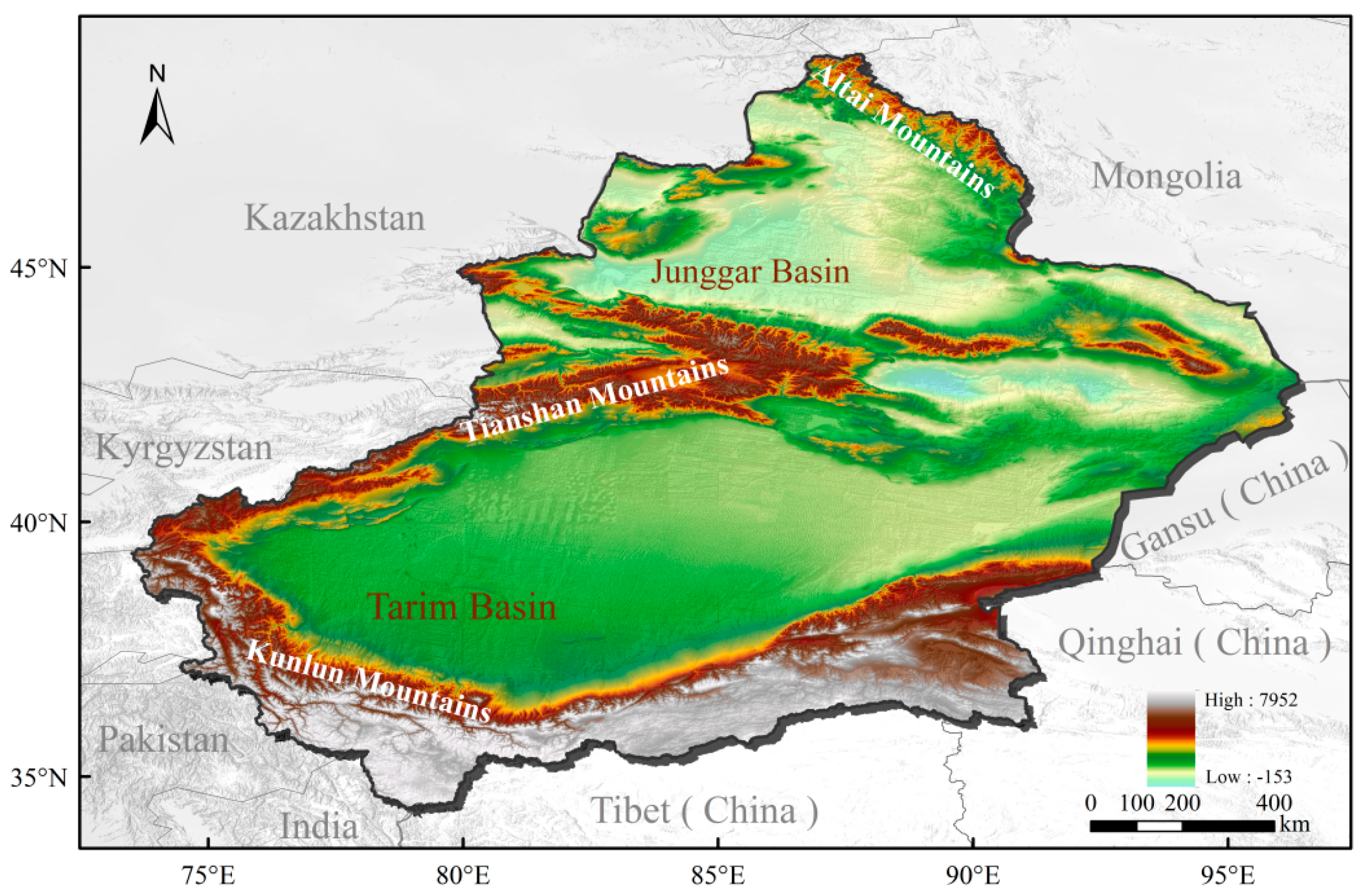
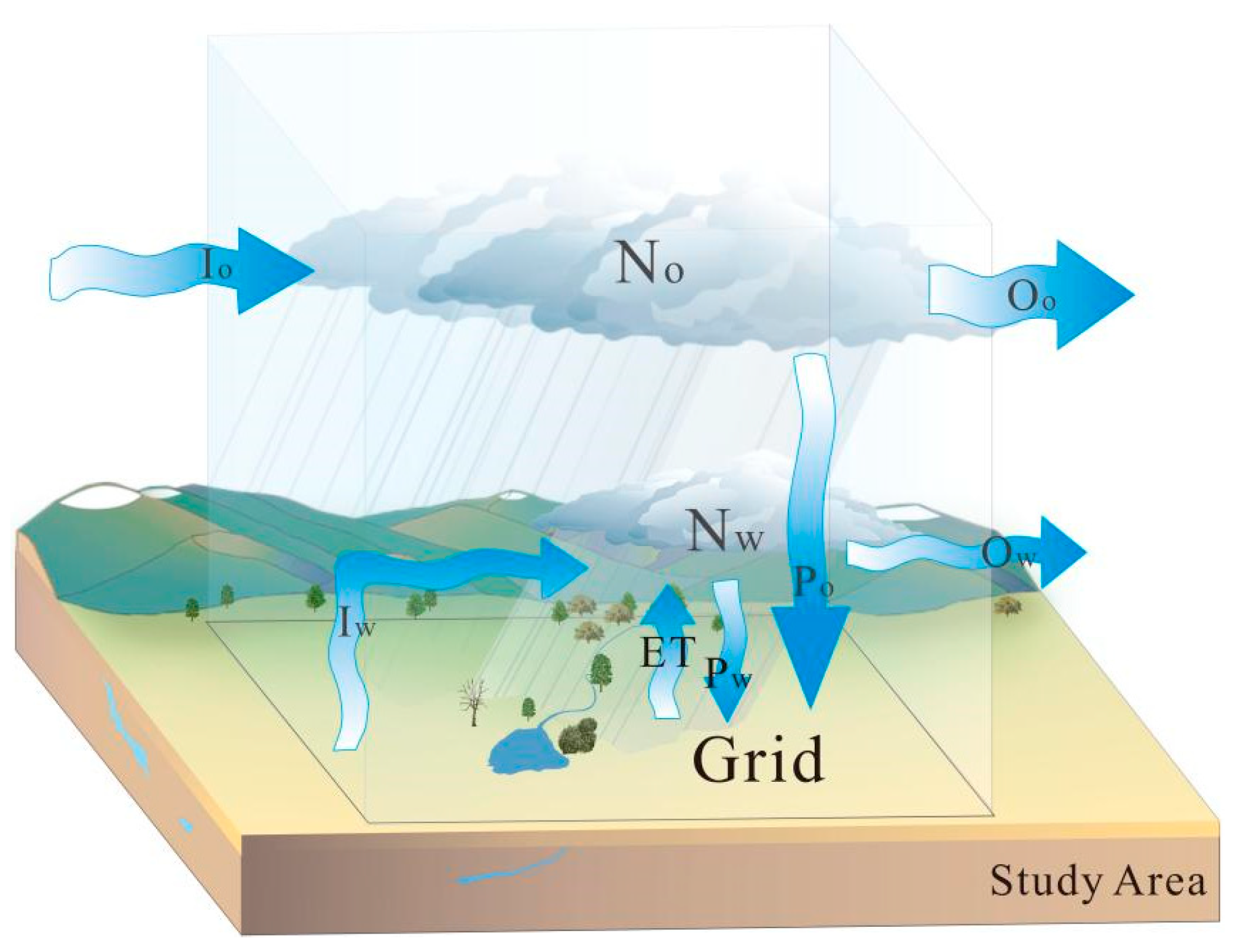
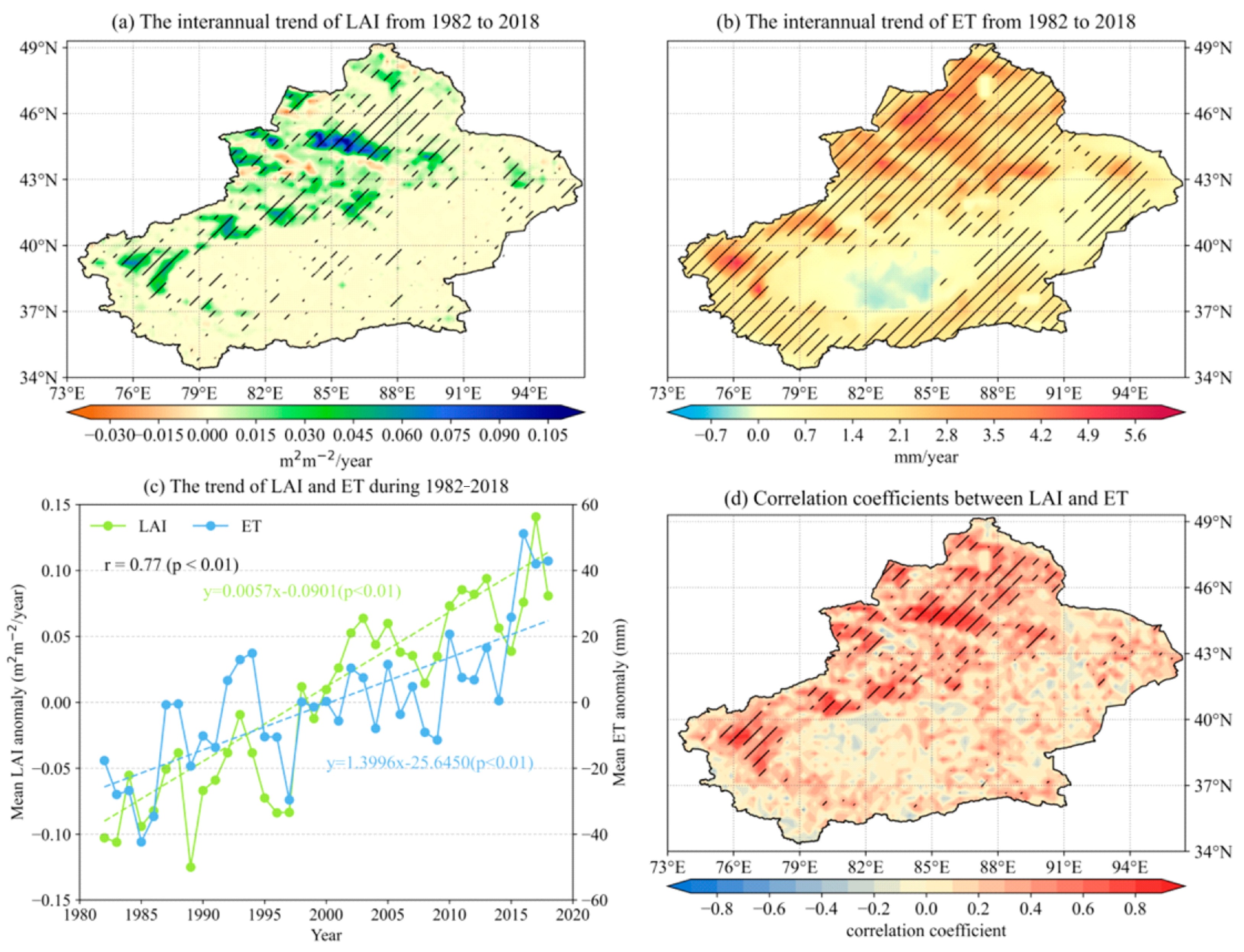
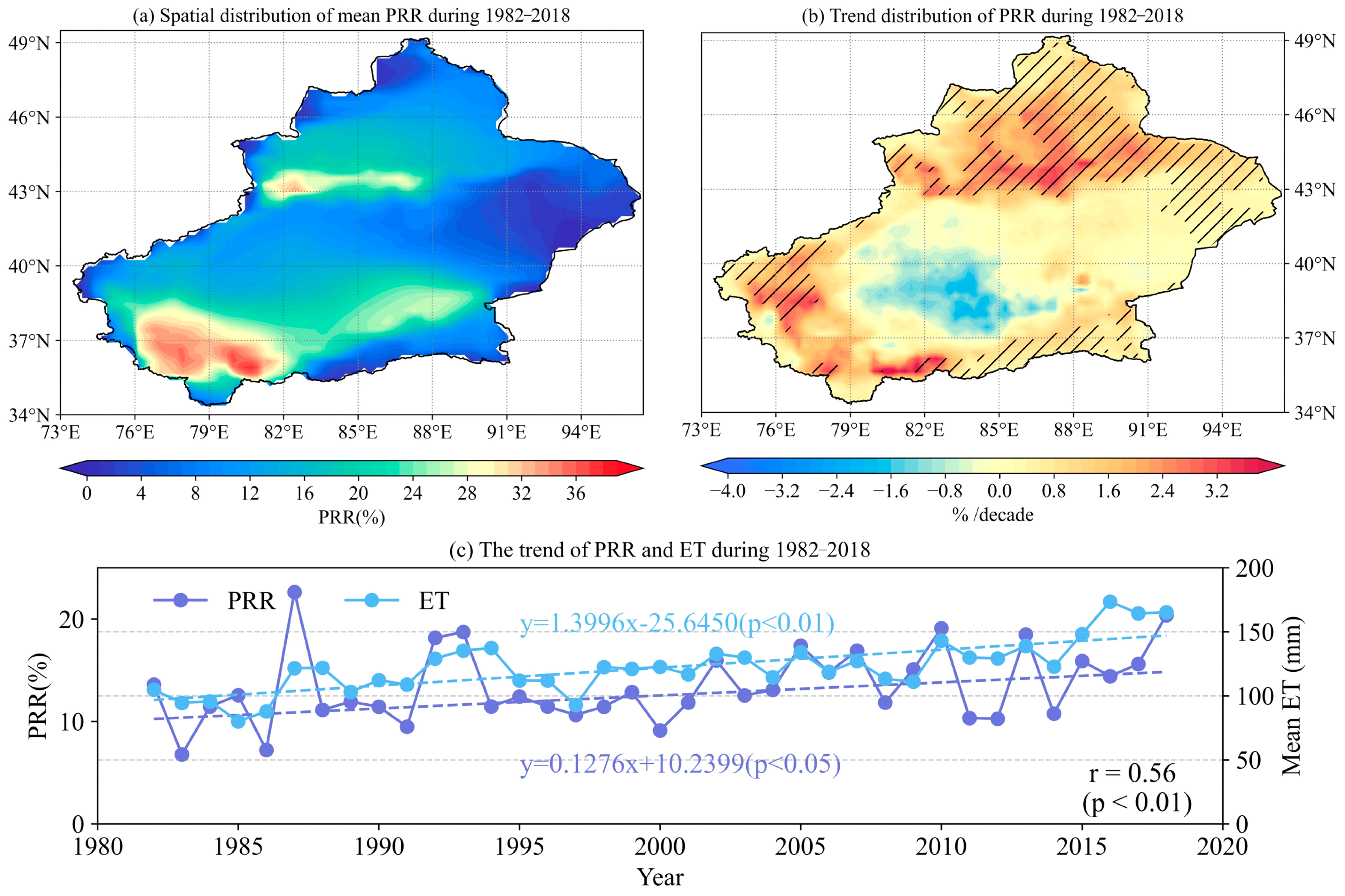

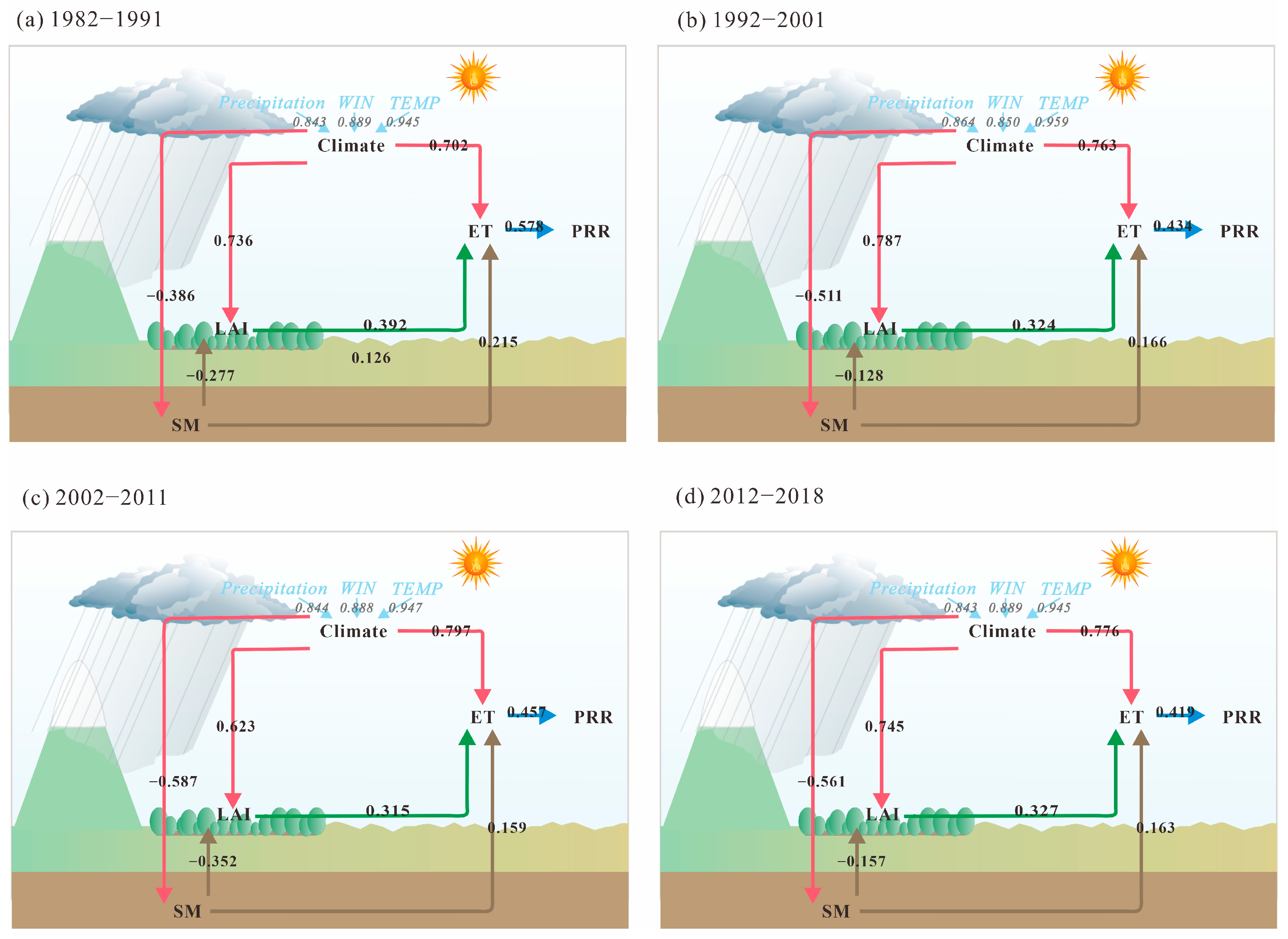
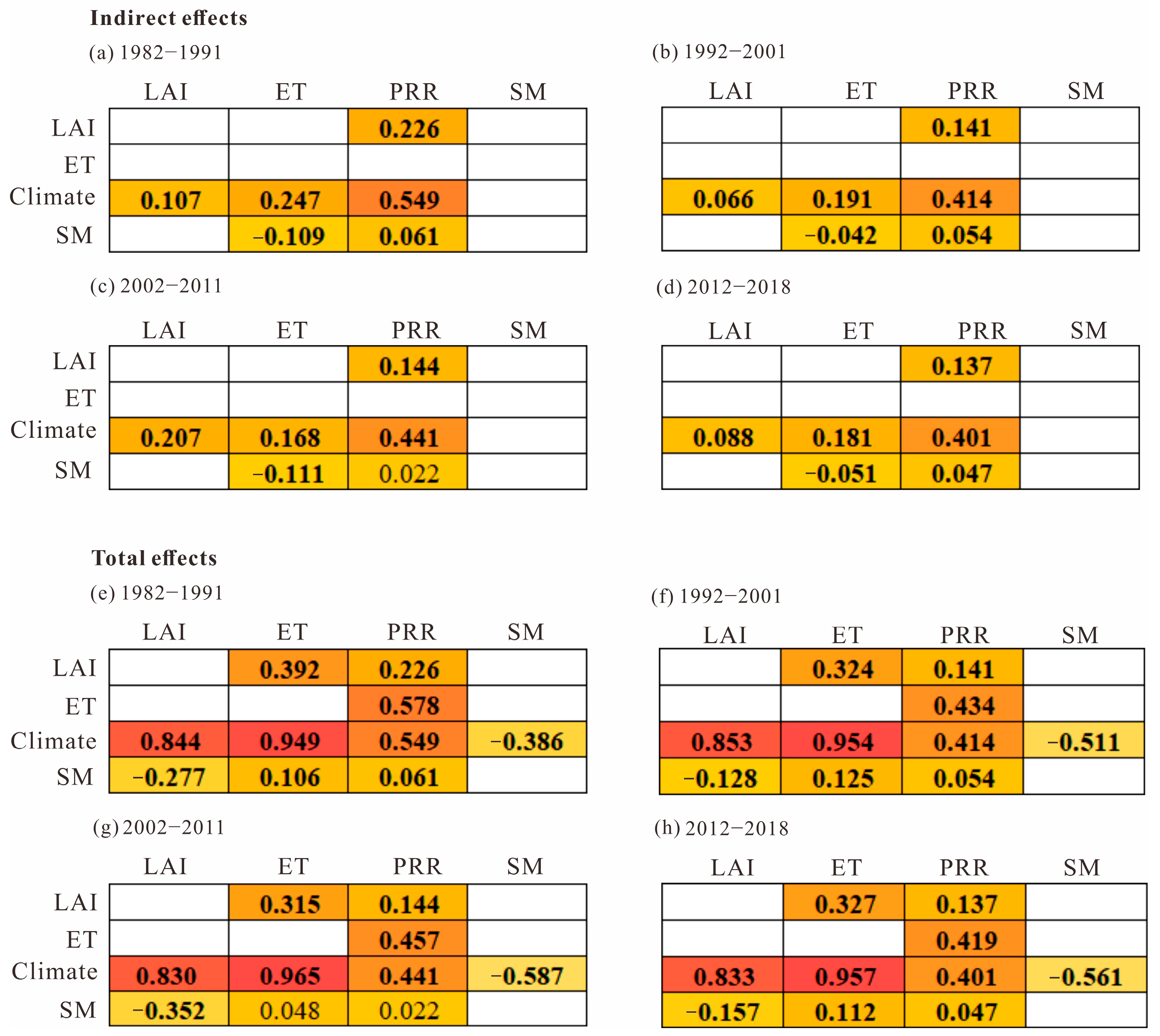
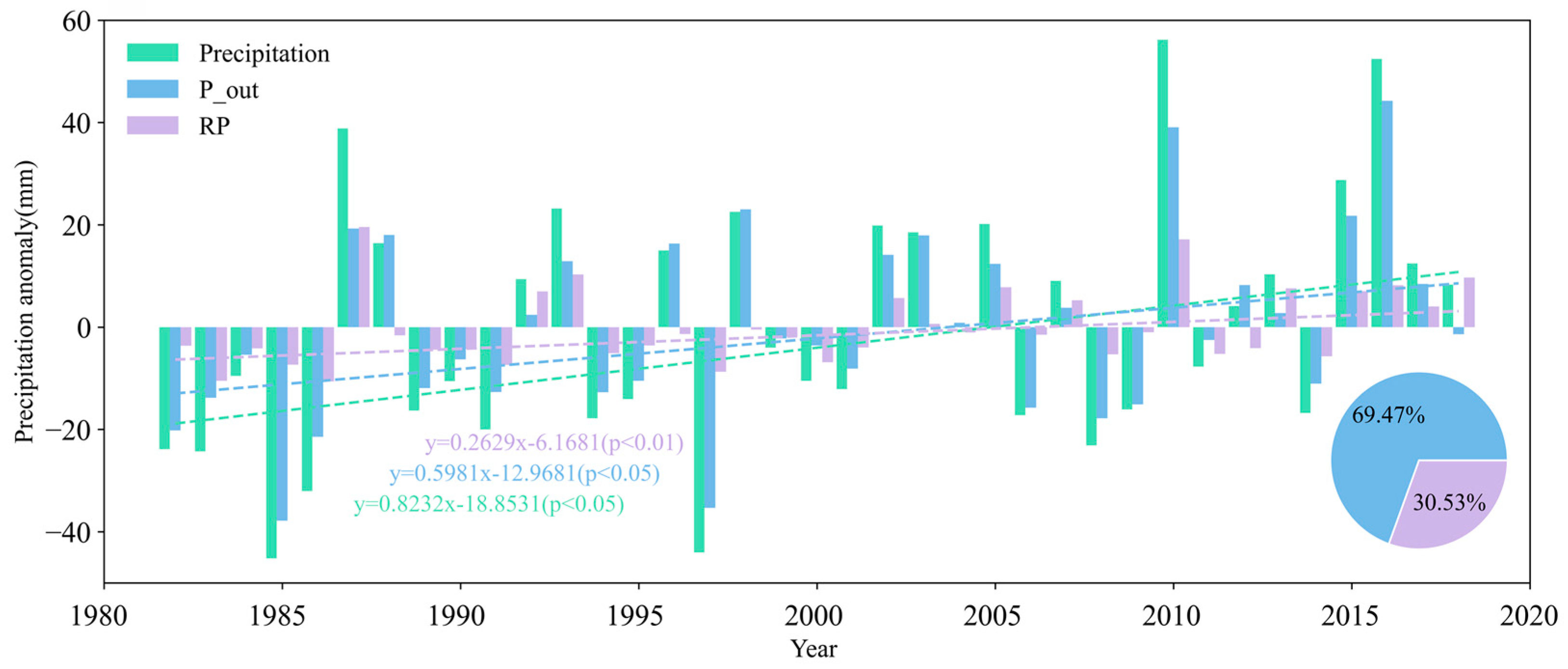
| Data | Website | Spatial Resolution | Temporal Resolution | Period |
|---|---|---|---|---|
| ERA5 | https://cds.climate.copernicus.eu/ (accessed on 5 November 2023) | 0.25° × 0.25° | 1 month | 1982–2018 |
| ERA5-land | https://cds.climate.copernicus.eu/ (accessed on 5 November 2023) | 0.1° × 0.1° | 1 month, 1 h | 1982–2018 |
| GLEAM | https://www.gleam.eu (accessed on 11 November 2023) | 0.25° × 0.25° | 1 month, 1 year | 1982–2018 |
| Daily precipitation dataset | https://data.tpdc.ac.cn/ (accessed on 20 November 2023) | 0.25° × 0.25° | 1 day | 1982–2018 |
| AVHRR | http://www.glass.umd.edu/ (accessed on 23 November 2023) | 0.05° × 0.05° | 8 days | 1982–2018 |
| ESA-CCI | http://maps.elie.ucl.ac.be/CCI/viewer/download.php (accessed on 22 October 2024) | 300 m × 300 m | 1 year | 1992, 2000, 2010, 2018 |
Disclaimer/Publisher’s Note: The statements, opinions and data contained in all publications are solely those of the individual author(s) and contributor(s) and not of MDPI and/or the editor(s). MDPI and/or the editor(s) disclaim responsibility for any injury to people or property resulting from any ideas, methods, instructions or products referred to in the content. |
© 2024 by the authors. Licensee MDPI, Basel, Switzerland. This article is an open access article distributed under the terms and conditions of the Creative Commons Attribution (CC BY) license (https://creativecommons.org/licenses/by/4.0/).
Share and Cite
Li, X.; Hao, X.; Zhang, S.; Hou, G.; Zhang, J.; Fan, X.; Zhao, Z. Vegetation Greening Promoted the Precipitation Recycling Process in Xinjiang. Remote Sens. 2024, 16, 4156. https://doi.org/10.3390/rs16224156
Li X, Hao X, Zhang S, Hou G, Zhang J, Fan X, Zhao Z. Vegetation Greening Promoted the Precipitation Recycling Process in Xinjiang. Remote Sensing. 2024; 16(22):4156. https://doi.org/10.3390/rs16224156
Chicago/Turabian StyleLi, Xuewei, Xingming Hao, Sen Zhang, Guanyu Hou, Jingjing Zhang, Xue Fan, and Zhuoyi Zhao. 2024. "Vegetation Greening Promoted the Precipitation Recycling Process in Xinjiang" Remote Sensing 16, no. 22: 4156. https://doi.org/10.3390/rs16224156
APA StyleLi, X., Hao, X., Zhang, S., Hou, G., Zhang, J., Fan, X., & Zhao, Z. (2024). Vegetation Greening Promoted the Precipitation Recycling Process in Xinjiang. Remote Sensing, 16(22), 4156. https://doi.org/10.3390/rs16224156






